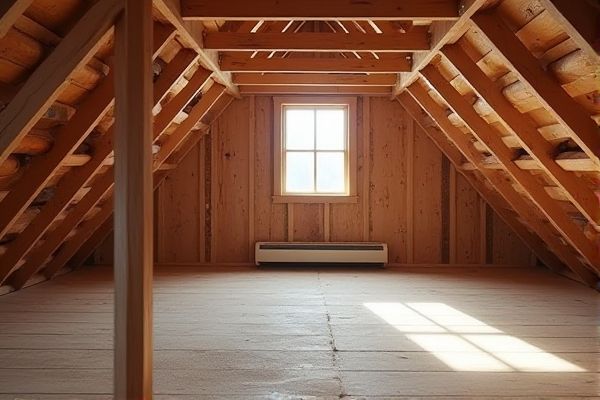
Attic electrical heaters provide targeted warmth in small, enclosed spaces, making them energy-efficient options for lofts, while baseboard heaters offer consistent, room-wide heat through convection, ideal for maintaining steady temperatures in living areas. Discover which heating solution best suits your home's needs and energy goals by exploring the detailed comparison ahead.
Table of Comparison
| Feature | Attic Electrical Heater | Baseboard Heater |
|---|---|---|
| Installation Location | Installed in attic space | Mounted on walls near floor level |
| Heating Method | Radiant and convection heating | Convection heating |
| Heat Distribution | Heats attic, may require ducting for rooms | Directly heats adjacent room air |
| Space Efficiency | Out of living space; saves room | Occupies wall space |
| Installation Complexity | Requires attic electrical setup and ventilation | Simple wall mounting and wiring |
| Energy Efficiency | Variable, depends on attic insulation and ducting | High efficiency with direct heat delivery |
| Maintenance | Less accessible; occasional filter/vent cleaning | Easy access for cleaning and inspection |
| Cost | Moderate to high (depends on attic setup) | Moderate installation and operating cost |
| Best Use Case | Whole-house heating with attic duct system | Heating individual rooms or zones |
Introduction: Attic Electrical Heater vs Baseboard Heater
Attic electrical heaters provide concentrated warmth in upper-level spaces, ensuring efficient heat distribution in areas prone to cold drafts and poor insulation. Baseboard heaters, installed along the floor, deliver consistent, low-profile heating ideal for maintaining steady room temperatures with minimal noise. Your choice depends on the specific heating needs, space configuration, and energy efficiency preferences of your home.
How Attic Electrical Heaters Work
Attic electrical heaters operate by converting electrical energy into heat through resistive heating elements installed in the attic space, efficiently warming the surrounding air. These heaters utilize thermostats to regulate temperature and maintain consistent heat output, preventing energy waste. Unlike baseboard heaters, which distribute heat primarily along walls at floor level, attic heaters can serve as centralized heat sources, optimizing warm air circulation from the attic throughout the home.
How Baseboard Heaters Operate
Baseboard heaters operate by using electric resistance to generate heat, which warms the air near the unit and allows it to rise naturally, creating a convection current that distributes warmth throughout the room. These heaters are typically installed along the base of walls and feature a series of metal fins that increase surface area for efficient heat transfer. If you're considering options for your attic or other spaces, baseboard heaters offer quiet, zoned heating with straightforward installation and precise temperature control.
Installation Requirements and Costs
Attic electrical heaters typically demand specialized installation due to limited space and ventilation needs, often increasing labor costs compared to baseboard heaters. Baseboard heaters generally require simpler mounting on walls with straightforward electrical hookups, resulting in lower installation expenses. Your choice between the two should consider both upfront installation costs and the complexity of integrating the heating system within your home's layout.
Energy Efficiency Comparison
Attic electrical heaters typically offer higher energy efficiency because they directly warm the air in confined spaces, reducing heat loss, whereas baseboard heaters distribute heat along walls but may experience more heat dissipation. Your choice should consider the insulation quality of the attic, as well-insulated attics maximize the effectiveness of electric heaters by maintaining consistent temperatures. Baseboard heaters often consume more energy over time due to their slower response and reliance on convection, making attic heaters a more cost-effective option for targeted heating.
Heating Performance and Coverage
Attic electrical heaters typically offer concentrated heating performance ideal for small to medium-sized spaces, providing efficient warmth in narrow attic areas with limited airflow. Baseboard heaters distribute heat more evenly along walls, covering larger rooms with consistent warmth due to their extended surface area and natural convection process. While attic heaters excel in targeted zones, baseboard heaters deliver broader coverage, making them suitable for whole-room heating in residential settings.
Safety Features and Considerations
Attic electrical heaters often come with built-in overheating protection and automatic shut-off features, reducing the risk of fire in confined attic spaces. Baseboard heaters provide reliable safety with temperature limit controls and cool-to-touch surfaces, making them ideal for living areas where direct contact is possible. You should evaluate the specific safety certifications and installation requirements of each heater type to ensure optimal protection in your home.
Maintenance and Longevity
Attic electrical heaters typically require less frequent maintenance due to sealed components, while baseboard heaters need periodic cleaning to prevent dust buildup that can reduce efficiency. Baseboard heaters tend to have a longer lifespan, often lasting 20 to 30 years, compared to attic electrical heaters, which may need replacement or significant service every 10 to 15 years. Understanding these differences can help you optimize your heating system's durability and reduce long-term maintenance costs.
Cost of Operation: Attic vs Baseboard Heaters
Attic electrical heaters generally have higher operating costs due to heat loss through poor insulation and extended runtime compared to baseboard heaters, which provide targeted, efficient heating at floor level. Baseboard heaters are often more cost-effective for maintaining consistent warmth in individual rooms because they use less energy to directly heat your living space. Evaluating insulation quality and specific heating needs can help you optimize your heater choice to reduce overall electricity expenses.
Which Heater Is Best for Your Home?
Attic electrical heaters offer efficient heat distribution in small, enclosed spaces and are ideal for homes with limited room for installation. Baseboard heaters provide consistent, zoned heating along walls, making them suitable for larger rooms or homes requiring targeted temperature control. Choosing the best heater depends on your home's layout, insulation quality, and heating needs for optimal energy efficiency and comfort.
 homyna.com
homyna.com